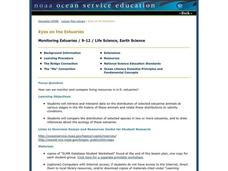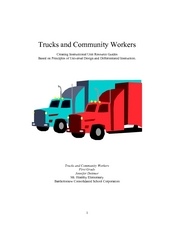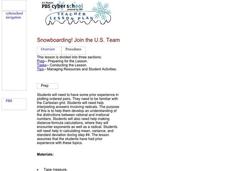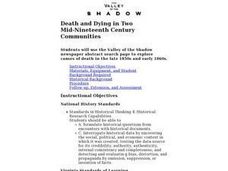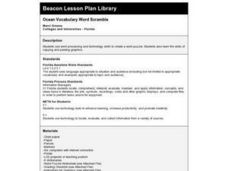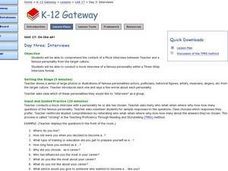Curated OER
Understanding Place Value
Fifth graders study place value. After forming teams, they play a game called, "Who Can Line Up the Number." Students observe numbers in expanded form and place representative digits in the correct order.
Curated OER
The International Monetary Fund, The World Bank, and the World Trade Organization: A Help or Hindrance to Developing Countries?
Eleventh graders study the International Monetary Fund, World Bank, and World Trade Organization. They collaborate in small groups to research and explore perspectives of each group, identify objectives of each group and key arguments...
Curated OER
UV Rays
Fourth graders study the effects of UV rays and practice finding the UV index for where they live. In this health lesson, 4th graders listen to a lecture about ultraviolet rays, then find the UV index in their area and write a story...
Curated OER
Get Smart
Young scholars study sustainability and smart growth. In this geography lesson students identify the benefits that are expected from smart growth.
Curated OER
Eyes on the Estuaries
Students study estuaries and compare several ones in the U.S. In this estuary instructional activity students interpret data and compare the distribution of different species.
Curated OER
A Reef of Your Own
Students study the reproductive strategies of reef building corals. In this coral reef lesson plan students describe the behaviors of reef building corals and their nutritional strategies.
Curated OER
Trucks and Community Workers
First graders identify community helpers and their roles. In this transportation lesson, 1st graders complete a series of lessons integrating technology and literacy. Students decode sounds of short u, c/s/ and g/j/ words and improve...
Curated OER
A Christmas Celebration in the Black Culture
How much does your class know about Kwanzaa? Using the Internet, pupils practice using the Internet to find information. They then compare and contrast the similarities and differences between Kwanzaa and Christmas.
Curated OER
Birthday Soup
Students utilize the story, "Chicken Soup With Rice, " by Maurice Sendak to compare the number of days in each month, research their birth date and navigate their way through a calendar.
Curated OER
McONE Hundredth Day
Students explore the components of a calendar and counting through the preparation and celebration of the "One Hundredth Day" of school. Badges are worn and McDonald fries are enjoyed in the celebration.
Curated OER
Irregularly Scheduled Programming
Students examine their favorite holidays and how they are celebrated. After reading an article, they discuss the length of television programming for the Super Bowl. In groups, they create their own television programming relating to...
Curated OER
Using a Calculator
Learners use a calculator to solve math problems. In this calculator usage lesson, students get into pairs and familiarize themselves with the keys. Learners are then given problems to solve using the calculator. Students do Smart Board...
Curated OER
Snowboarding! Join the U.S. Team: Olympics, Math, Weather
High schoolers make weather predictions and observations, research the cost of snowboarding equipment, and use their math skills to plot the course of a Giant Slalom Snowboarding event.
Curated OER
Digital Photographers
Young scholars discover the uses of a digital camera by taking photos and uploading them to a personal computer. Then they use software to edit the photos and practice making them look different in a variety of ways. The lesson includes...
Curated OER
Causes of Death in the 19th Century
Students analyze historical data. They explore the context in which it was created. They develop skills in historical analysis.
Curated OER
Watching the People: 2
Students answer specific questions on the current economic climate in China. They see effects of economic reforms on people they have met in the documentary and provide the impetus for "conversation" among the people students have met in...
Curated OER
Create a Dichotomous Key of Idaho Reptiles
Students use the reptile section of the Digital Atlas of Idaho. They make a dichotomous key and decide on what defining characteristics they can use to distinguish between species. They hone their observation skills and recognize...
Curated OER
Ocean Vocabulary Word Scramble
Students visit a puzzle maker website and follow a list of instructions, creating a word scramble using sea animal vocabulary. They copy and paste graphics at the bottom of their puzzle, and print them out for other students to solve.
Curated OER
What to do with Malus-domestica, Cultivated Apples?
Students take on the roles of apple farmers. In this Arizona agriculture lesson, students explore the concepts of supply and demand as they role play apple farmers who create marketing campaigns when supply outweighs demand.
Curated OER
How Has Technology Affected the Presidential Election Process in the U.S.?
Students measure technological advancements as they consider how they impacted the election process in the United States. For this presidential politics lesson, students research technological changes since the 1900's and create...
Curated OER
You Are Here
Students simulate a course with and without a guide as if they were an airplane with and without air traffic control. They read and discuss the article "For Airlines, Hands-On Air Traffic Control". They discuss challenges that air...
Curated OER
Making Your Own National Park Geologic Tour
Students research national parks. In this geology lesson, students identify the geological features of selected national parks and create PowerPoint presentations that feature their findings.
Curated OER
On the air! Interviews
In this mock interview lesson, students view pictures of famous personalities and determine which of these personalities they would like to interview. Students follow the three step interview process and conduct a mock interview...
Curated OER
Our Geometric World
Third graders explore the attributes of polygons. In this geometric shapes lesson, 3rd graders review quadrilaterals, squares, rectangles, triangles, pentagons, hexagons, and octagons in order to create hanging polygons. Students then...




